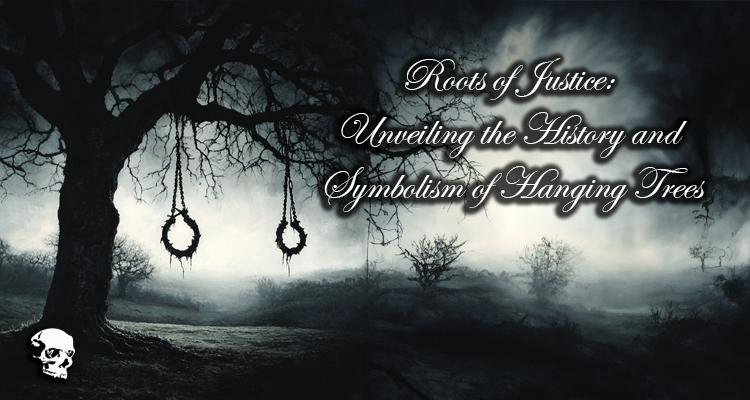Currently Empty: $0.00

Roots of Justice: Unveiling the History and Symbolism of Hanging Trees
Throughout history, certain symbols become entwined with the darkest aspects of human society. Among these, the “Hanging Tree” stands out as a potent reminder of justice, punishment, and the deep scars left by public executions. The image of a tree as a place of death has permeated various cultures and epochs, making it an enduring symbol that carries a weight of historical and emotional significance. This article delves into the historical, cultural, and symbolic meanings associated with Hanging Trees, tracing their legacy through the ages.
The Role of Hanging Trees in Public Executions
In 18th and 19th century England, Hanging Trees were not just a site of execution but a focal point of public spectacle. These trees often stood at the crossroads of society’s desire for retribution and the enforcement of law and order. Public executions were designed to be both a punishment for the condemned and a powerful deterrent for others, with the Hanging Tree acting as a silent witness to these gruesome displays.
Crowds would gather, drawn by the morbid fascination of death, the finality of justice, and the societal ritual of witnessing an end. Over time, as societal attitudes evolved, the public’s appetite for such macabre gatherings waned, leading to the decline of the Hanging Tree’s role in executions. This shift marked a broader transformation in the cultural understanding of justice, punishment, and human dignity.
Hanging Trees in Folklore and Collective Memory
Beyond their historical use, Hanging Trees have seeped into the collective memory and folklore of various regions, particularly in the American West during its settlement period. These trees, often the site of lynchings and extrajudicial executions, became symbols of frontier justice—where the rule of law was as harsh as the landscape.
Over time, these Hanging Trees took on a life of their own in folklore, evolving into legendary objects surrounded by myths, whispers of ghostly encounters, and dark tales of retribution. In places like California, these trees have been preserved as “witness trees,” standing as silent testimonies to the brutal practices of the past, and serving as a somber reminder of the darker chapters in history.
Memorializing the Past: The Archaeological Significance of Hanging Trees
As societies reflect on their histories, certain sites of past violence, including Hanging Trees, have been preserved as memorials. These memorials serve not only as historical markers but as places of deep emotional resonance, where communities can connect with the past, confront its horrors, and sometimes seek reconciliation.
For instance, in Finland, the tree that marked the site of the last official hanging has been memorialized, transforming a site of execution into a space of collective memory. This shift from a symbol of death to a site of reflection highlights how societies evolve in their relationship with the past, moving from glorification of punishment to a more nuanced understanding of its impact.
Religious and Symbolic Interpretations of the Hanging Tree
The symbolism of the Hanging Tree extends beyond its physical and historical presence; it also holds significant religious and metaphorical weight. In Christian theology, the phrase “hanging on a tree” is often associated with the crucifixion of Jesus, representing a cursed death according to Jewish law.
This metaphorical use of the Hanging Tree emphasizes themes of shame, sacrifice, and divine judgment, intertwining the symbol of the tree with broader religious and moral discourses. The enduring power of this imagery speaks to its ability to evoke deep, often uncomfortable, reflections on human suffering, justice, and redemption.
Artistic and Literary Depictions of the Hanging Tree
The image of the Hanging Tree has found its way into literature and art, often serving as a symbol of the darker aspects of human nature and society. From medieval iconography depicting the suicide of Judas to contemporary literature, the tree is often portrayed as a place of both justice and curse. Artists and writers have long been drawn to the morbid allure of the Hanging Tree, using it to explore themes of guilt, societal judgment, and the inexorable pull of fate. These depictions contribute to the tree’s enduring legacy, ensuring that its image remains a powerful, albeit unsettling, reminder of the consequences of human actions.
The Weight of Memory: Reflecting on the Legacy of Hanging Trees
As we contemplate the legacy of Historical Hanging Trees, it becomes clear that they are much more than mere objects in the landscape—they are deeply ingrained in the cultural, religious, and emotional fabric of society. These trees, once sites of brutal public displays of justice, have transformed into symbols of reflection, memory, and sometimes, a desire for atonement.
They remind us of a time when justice was as harsh and unforgiving as the wood from which the condemned hung, but they also challenge us to consider how far we have come, and how these dark symbols have evolved in our collective consciousness. The Hanging Tree, in all its historical complexity, continues to cast a long shadow over the way we remember our past and understand our present.
Are you enjoying this article or our site? Love of Gothic and the Dark Matters & Mischief magazine are run by dedicated volunteers, and we rely on crowdfunding to cover our expenses. Your support is crucial to keep us going! Consider becoming a paying member of our Patreon or purchasing something from our shop to help us continue providing content and community support. Thank you for your support!

